My one-week Serbia itinerary visiting three of the top cities in Northern Serbia plus one national park is ideal for first-time visitors.
From the concrete jungle of gritty Belgrade to the pretty Art Nouveau towns in the north, Serbia is a haven for wine-lovers, electronic music fans, architecture buffs, Yugo-nostalgics and hikers alike.
Admittedly I’m none of those things – but I thoroughly enjoyed trying a little bit of everything when I spent a fortnight travelling around Serbia last winter.
My Serbia itinerary brings sews together the best parts of the country’s north for an easy 7-day tour by bus or train.
Based off the route I followed on my trip around the Balkans, it’s packed with actionable advice – including the best things to do in Serbia, instructions for getting around, and other handy tips.
Are you planning a visit to Serbia?
– Don’t miss my in-depth guide to Novi Sad, Serbia’s coolest city.
– Check out my Balkans Travel Guide for tips and recommendations for bordering countries.
– If you love road tripping, don’t miss my Balkans road trip planner for inspiring routes around Serbia and beyond.
Please note: This post contains affiliate links, meaning I may earn a commission if you make a purchase by clicking a link (at no extra cost to you). Learn more.
Serbia itinerary essentials
I travelled pretty extensively through all 12 Balkan states and I think Serbia is one of the easiest countries in the region for travellers. The intercity bus system is great and easy to navigate, accommodation options are plentiful, and English is widely spoken, which makes it easy to troubleshoot any logistical issues.
Here are my tips for planning the perfect Serbia itinerary.
Do you need a visa for Serbia?
Serbia’s tourist visa policy is very similar to the Schengen countries (although it is not included in the Schengen Area). Citizens of 96 countries (including Australia, the UK and the US) can visit Serbia visa-free for up to 90 days within any 180-day period.
Some nationalities (including some countries in Asia, the Middle East and Africa) are required to apply for a visa in advance.
I recommend using iVisa to check if you need a visa and to apply for an expedited visa online.
Where to start your Serbia itinerary
Belgrade (Serbia’s capital city) is the country’s main transport hub and the natural place to start your travels if you’re flying into the country. There are also regular coach bus connections between Belgrade and neighbouring countries: Hungary, Romania, Croatia and Bosnia and Herzegovina.
Having said that, I don’t necessarily recommend starting your Serbia travels in Belgrade.
Belgrade is quite a polarising city that many people find overwhelming (or underwhelming, depending how you look at it). I wasn’t a huge fan of Belgrade myself, and I think that if I had started my trip there, it probably would have coloured my impression of the whole country.
Instead, I recommend you start your Serbia itinerary in Novi Sad, the second-biggest city, also located in the north. The two are a mere hour-and-a-bit apart, so you can easily transit to Novi Sad by bus after you arrive in the capital. If you’re flying into Belgrade, I recommend pre-organising an airport transfer to take you to the bus station.
Of course this is just my opinion – you could easily flip this itinerary and start with a few days in the capital before continuing north.
If you happen to be entering Serbia overland from Hungary, western Romania or eastern Croatia, you can easily find bus services to either Novi Sad or Subotica. We entered the country from Osijek in Croatia and had Novi Sad as our first stop.
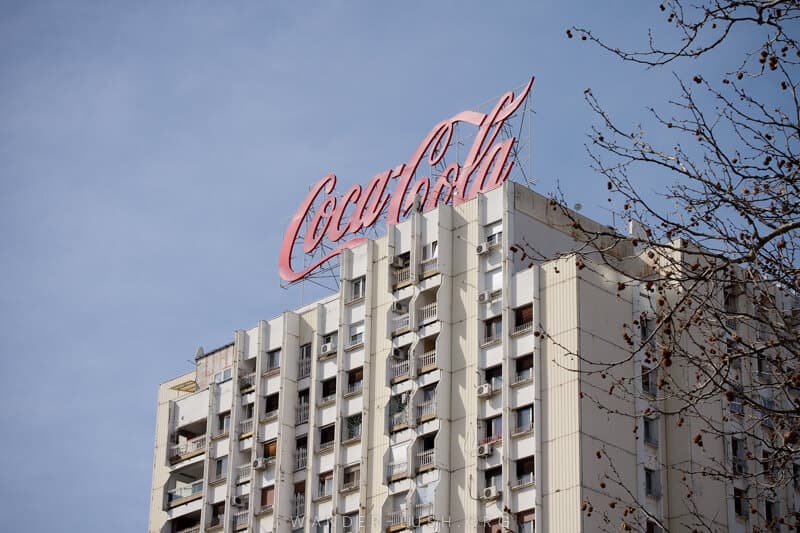
When is the best time to visit Serbia?
Belgrade, Novi Sad and Subotica are all destinations you can visit at any time of year.
Because of the way our 6-month Balkans itinerary worked out, we ended up in Serbia in March, which was admittedly still a little chilly and grey for our liking. If I had a choice, I would visit Serbia in late springtime as this season seems to have the best weather conditions.
Summer (June to August) is the hottest time of year in Serbia, and temperatures in concrete-heavy Belgrade can be oppressive. On the other hand, summer and early fall is a great time to go hiking in Serbia’s national parks. If you’re interested in food and wine, fall is also great for experiencing the wine harvest.
Getting around Serbia by bus
Serbia’s bus system is one of the best we encountered in the Balkans. Services are plentiful, fares are well-priced, and in our experience, everything runs true to schedule. We travelled around the country (and the entire Balkans region) exclusively by coach bus. Lasta is the most popular and reliable coach company in Serbia.
I suggest using the Polazak website to find bus schedules and fares in English. We always bought our bus tickets from the station a day in advance – especially recommended if it’s summer or a holiday. You also have the option to buy your tickets online using the Polazak website, although extra charges usually apply.
Bus stations in Serbia have a few quirks. Some of the bigger stations charge entry to access the platforms (usually a couple of dollars equivalent in local currency), meaning you have to buy a platform token in addition to your bus ticket.
Coaches always charge extra for any luggage you want to store under the bus. When we travelled in Serbia, the cost was 60 denars (approx. 60 US cents) per piece of luggage. Bags are tagged before being stowed and you have to present your ticket stub to collect them again, so don’t lose it.
Hiring a car in Serbia
Self-driving can be a good option for confident drivers if you want more flexibility in your itinerary. Serbia has some of the best roads in the region and cheap car rentals; however fuel prices and tolls are on the expensive side. Here are more tips for driving in Serbia.
Personally I recommend using Serbia’s bus network – it’s cheap and efficient. If you do decide to self-drive, I suggest using the Discover Cars website to explore your options and find the best price on a rental. They aggregate a good range of manual and auto transmission cars from international hire companies, with the option to pick up a vehicle in either Belgrade or Novi Sad.
Click here to find a rental car in Serbia using Discover Cars.
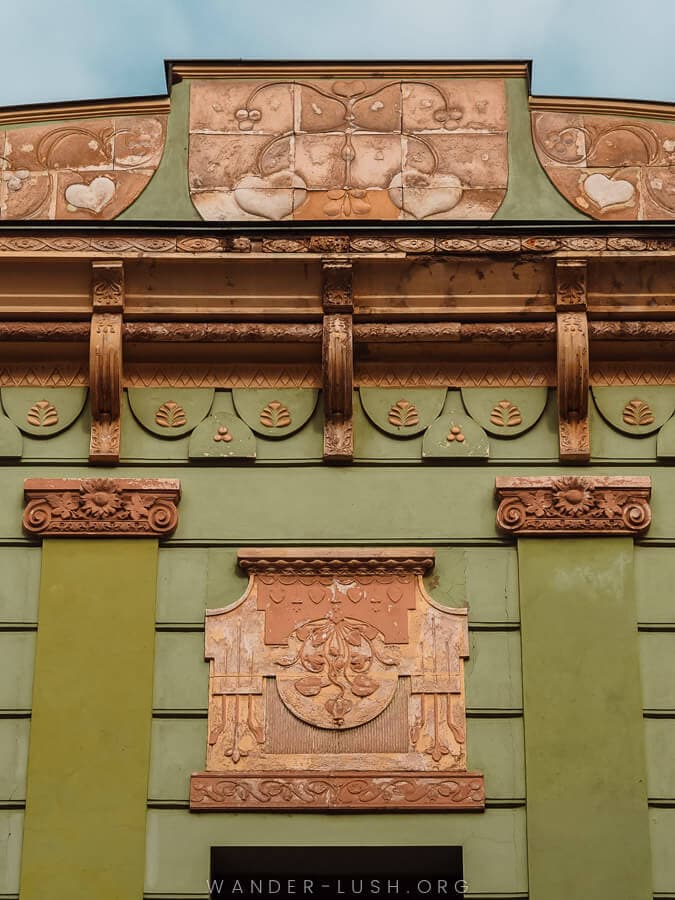

Where to stay in Serbia
The final piece of the Serbia logistics puzzle is accommodation. Finding a place to stay in Serbia is very easy, especially in the cities. Hostels, guesthouses and boutique hotels are all widely available. Private apartments are also very popular and can be booked either through Airbnb or Booking.com.
We used Airbnb throughout Serbia and had consistently good experiences. As with the rest of the region, Airbnb is a great choice if you want something self-contained and well-priced.
I’ve included specific accommodation recommendations (including links to the places we stayed at) in the itinerary below.
How much to budget for your trip
Serbia is a very affordable travel destination by European standards. For context, we found prices cheaper than Croatia or Slovenia, but slightly more expensive than Bosnia and Herzegovina or Montenegro.
Belgrade was one of the more expensive Balkan capitals we visited. To keep costs down, I recommend using Airbnb and eating at local restaurants.
- Budget traveller: 20-30 USD/day (hostel, buses, local meals)
- Mid-range: 30-50 USD/day (guesthouse or Airbnb, buses & taxis, restaurant meals)
- All-out: 50-100+ USD/day (boutique hotel, taxis & private transfers, restaurant meals)
We spent roughly 56,000 denars (approx. 570 USD) for two people for two weeks of travel in Serbia, excluding accommodation.
The perfect 7 days in Serbia itinerary
[Belgrade] – Novi Sad – Subotica – Belgrade – Tara National Park (Mokra Gora)
This Serbia itinerary focuses almost exclusively on the north, with more options to continue your travels in the south at the end. True to my travel style, it prioritises culture, history, food and wine over outdoor activities – although there is one national park included.
As I mentioned, we spent two weeks in Serbia and followed this exact itinerary, albeit at a slower pace. I think one week is the perfect amount of time to spend in Serbia if you’re a first-time visitor and you don’t mind moving around at a reasonably face pace.
Days 1 & 2: Start your Serbia itinerary in Novi Sad
Serbia’s second-largest city and capital of the Autonomous Province of Vojvodina, Novi Sad is the perfect introduction to Northern Serbia.
Novi Sad has a classic European feel thanks to its Hapsburg-era architecture and multitude of outdoor cafes. The Danube runs through the heart of the city, giving it notes of Budapest with a distinctly Serbian edge. One of the many must-dos in Novi Sad is to try the locavore restaurants and wineries that make use of local produce.
Roam the pedestrian boulevard in search of your next kafa hit, duck into Danube’s Park for a stroll under the trees, and seek out the pretty walkways and interiors along the main street.
Novi Sad was considered Serbia’s cultural capital up until the early 20th century and was at one time known by the nickname ‘Serbian Athens’. This legacy lives on in the dozens of literary and music festivals held throughout the year, most famously EXIT Festival, which takes place on the grounds of Petrovaradin Fortress every summer.
In 2021, Novi Sad will take up its position as European Capital of Culture, an accolade that’s sure to cement its reputation as one of the loveliest cities to visit in the Balkans.
I recommend spending a full day in Novi Sad and adding an extra day to your itinerary for a side trip to the town of Sremski Karlovci.
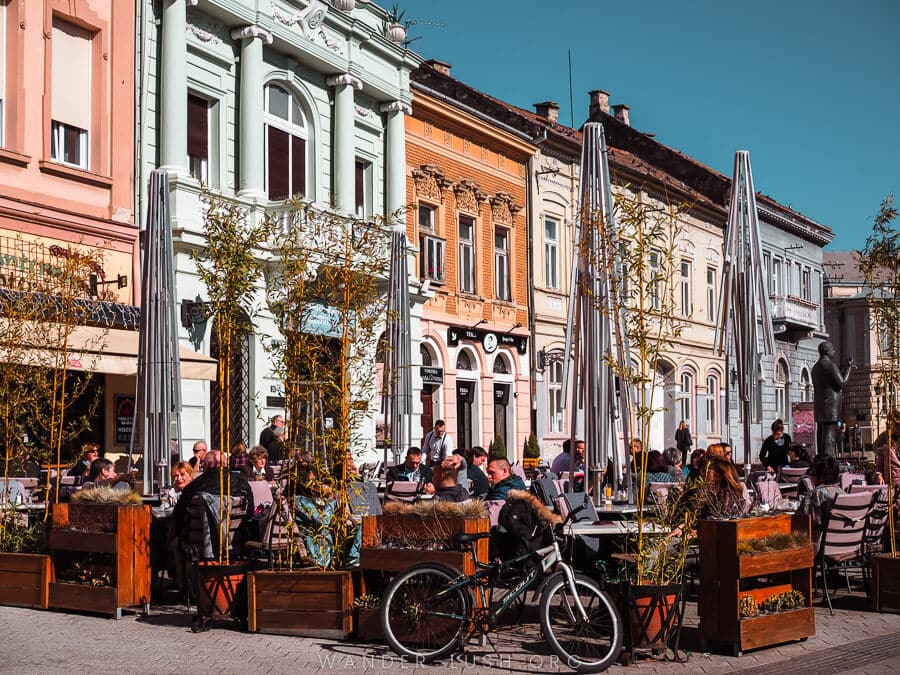
Things to do in Novi Sad
- Saunter down Dunavska Street to Trg Slobode. Novi Sad’s pedestrian mall is lined with beautiful architecture, cute shops and outdoor cafes. The main square, Trg Slobode, is where you can find some of the city’s most spectacular buildings including the Name of Mary Cathedral.
- Eat lunch at Project 72. A locavore feast in one of the city’s most beautiful dining rooms.
- Sunset at Petrovaradin Fortress. Wander across the river to take in the views from Novi Sad’s fortress. There is an outdoor terrace bar perfectly positioned for a sunset view over the river. Arrive early to explore the complex, with its clock tower, draw bridges and stone tunnels.
- Take a day trip to Sremski Karlovci. Northern Serbia’s prettiest town is just 30 minutes from Novi Sad by bus. Discover the Baroque architecture (including the colourful Grammar School) and visit the gorgeous Museum of Beekeeping. There are several small wineries in town that offer tastings (Podrum Bajilo and Winery Mrdjanin are both recommended). A local bus to Sremski Karlovci from Novi Sad costs 300 denars (approx. 3 USD) per person return.
For more excellent things to do in Novi Sad, read my Novi Sad city guide.
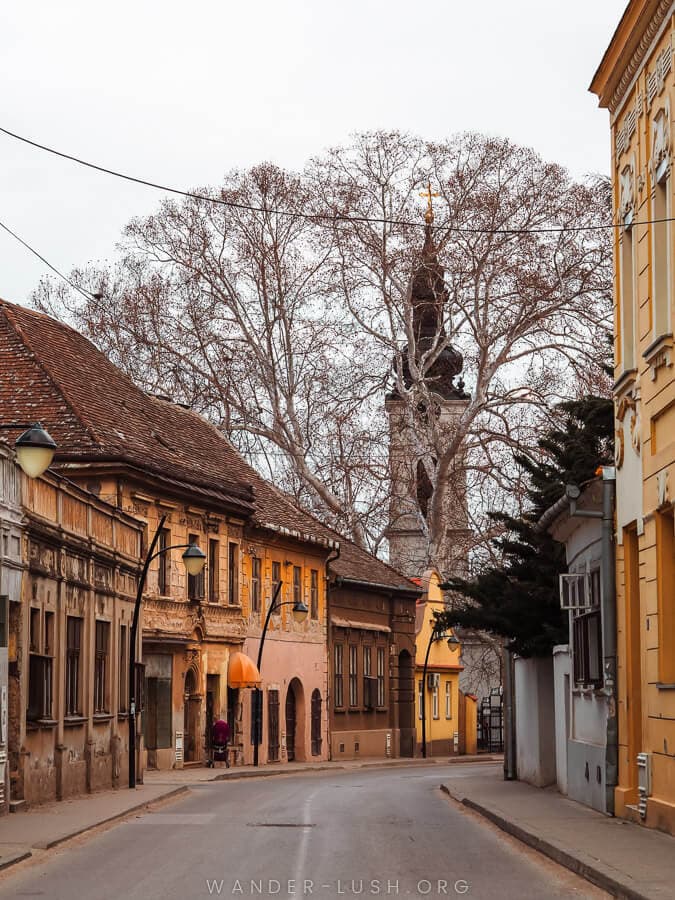
Where to stay in Novi Sad
When we visited Novi Sad, we stayed at this centrally located Airbnb. Nikola, the host, is very kind and helpful, and the location of the self-contained flat can’t be beat.
If you prefer a hotel, these properties are all centrally located and have excellent ratings (9/10 or higher) on Booking.com:
- Budget hostel: City Hostel
- Mid-range hotel: Garni Citi Hotel Veliki
- Boutique hotel: Hotel Fontana
Day 3: Make your way north to Subotica
Subotica is located an hour north of Novi Sad, very close to the Hungarian border. A small, quiet city by any measure, Subotica is full of architectural treasures and stands out as my absolute favourite place in Serbia.
Subotica is normally associated with one thing: Art Nouveau. Along with its sister city Szeged over the border, Subotica boasts some of the most divine examples of this architectural style anywhere in Europe. The most famous of all is the Raichle Palace (pictured at the top of this article and again below), a private residence built in 1904.
Like Novi Sad, Subotica is an outdoor city whose streets beg for long afternoon walks. A day is the perfect amount of time to explore Subotica on foot, with time for a trip to Palic Lake in the late afternoon.
How to get to Subotica from Novi Sad
There are bus departures at least once an hour from Novi Sad’s MAS Central Bus Station to Subotica, starting from 6am and continuing until around 9pm. (Note that Novi Sad has multiple bus stations – be sure to double check in advance.) Travel time to Subotica is just over 60 minutes depending on traffic conditions.
When booked online through Polazak, Tickets cost between 4-7 Euros depending on the service. We paid 7.90 denars (approx. 8 USD) per person for tickets when we travelled. Check times and prices here.
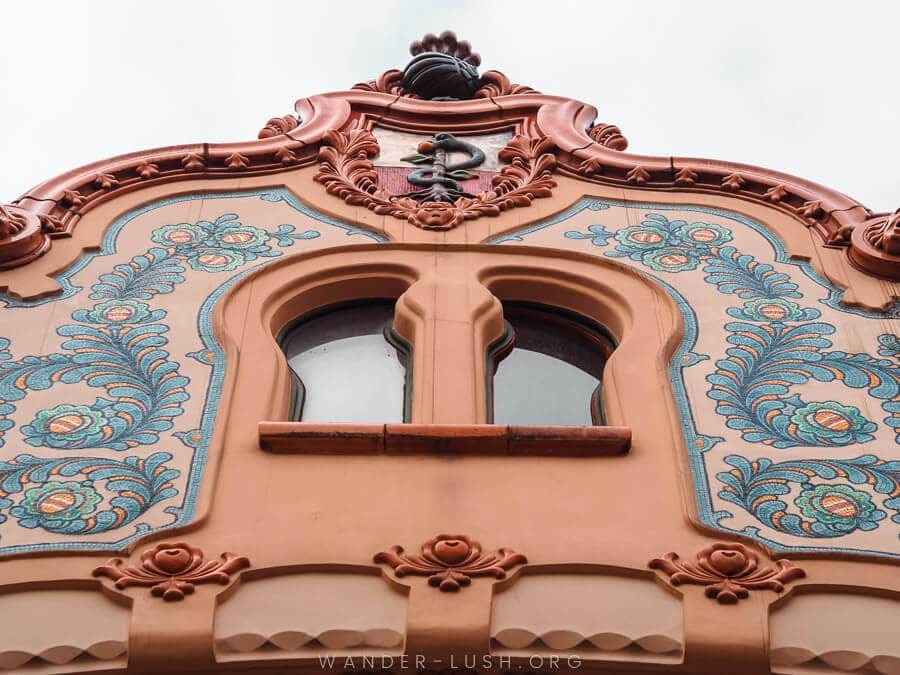
Things to do in Subotica
- Take a self-guided walking tour of Subotica’s architecture. Subotica Tourism has put together several DIY audio tours through the city that you can follow to see the prettiest buildings. We listened to three of the four tracks and really enjoyed the experience. Highlights of the Art Nouveau tour include the Town Hall building on the main square, the National Theatre and of course the Raichle Palace.
- Go inside Subotica Synagogue. If Raichle Palace has the prettiest facade, Subotica Synagogue definitely holds claim to the most impressive interior. This is seriously one of the most evocative buildings I’ve ever been inside (I liken the experience to visiting the Sagrada Familia). Completed in 1902, it’s no longer active but has been expertly restored with help from the World Monuments Fund. The story of Subotica’s Jewish community is wrapped up in the building and is very, very moving – I highly recommend reading up before you go. The synagogue is open from 10am-6pm every day except Monday. Entrance costs 250 denars (approx. 2.50 USD) per person and is worth every cent.
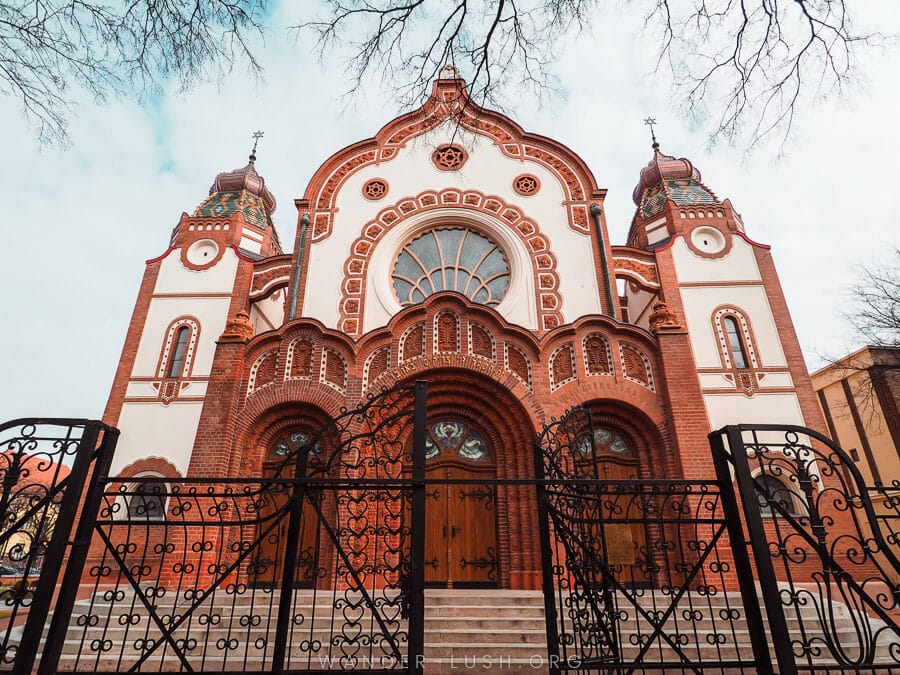

- Eat lunch at Boss Caffe. Located in the courtyard behind Richle Palace, this local favourite features outdoor dining surrounded by flourishes of Art Nouveau. We ate here twice and really enjoyed the food. The menu is huge and well-priced; we paid 1000 denars (approx. 10 USD) for lunch for 2 people.
- Take a side trip to Lake Palic. Just 10km from Subotica (around 20 minutes by local bus), Lake Palic used to be an elite spa retreat. It features yet more beautiful Art Nouveau architecture, most notably the Grand Terrace complex on the shore of the lake (it now houses a cafe), and a handful of villas tucked in the forest beyond. We walked around the lake accompanied by one of the audio tour tracks.
Where to stay in Subotica
We stayed at the cute Apartment Libra in Subotica, a very comfortable, well-positioned flat with a great kitchen. It was very warm and cosy in winter, and our host Ljubomir even picked us up from the bus station when we arrived.
Other options in Subotica:
- Budget hostel: Hostel Put Svile
- Mid-range hotel: Hotel Forum Garni
Days 4 & 5: Continue to the big city, Belgrade
Now that you’ve eased your way into Northern Serbia, it’s time to hit the big city.
Before visiting, I only ever associated Belgrade (the ‘White City’) with socialism and Yugoslav history, not realising that it’s actually one of the oldest continuously inhabited cities in Europe. Yes, it’s mostly grey concrete on the surface, but there are countless layers of Roman, Ottoman and Yugoslavian heritage to peel back, and no shortage of excellent museums and walking tours to help you do it.
For a balanced experience, I recommend dividing your time in Belgrade between the distinctive ‘old’ and ‘new’ (Socialist) parts of the city, located on the eastern and western banks of the river respectively.
How to get to Belgrade from Subotica
There are a dozen coaches to Belgrade from Subotica every day, departing from the bus station near the railway station and terminating at the BAS Central Bus Station in Belgrade. Buses start running in the early morning (around 4am) and continue until 6pm. Travel time is 3-3.5 hours depending on the service.
Tickets cost 8-12 Euros when purchased online. When we travelled, we paid 1,235 denars (approx. 12.70 USD) per person for tickets purchased at the bus station. Check times and fares here.
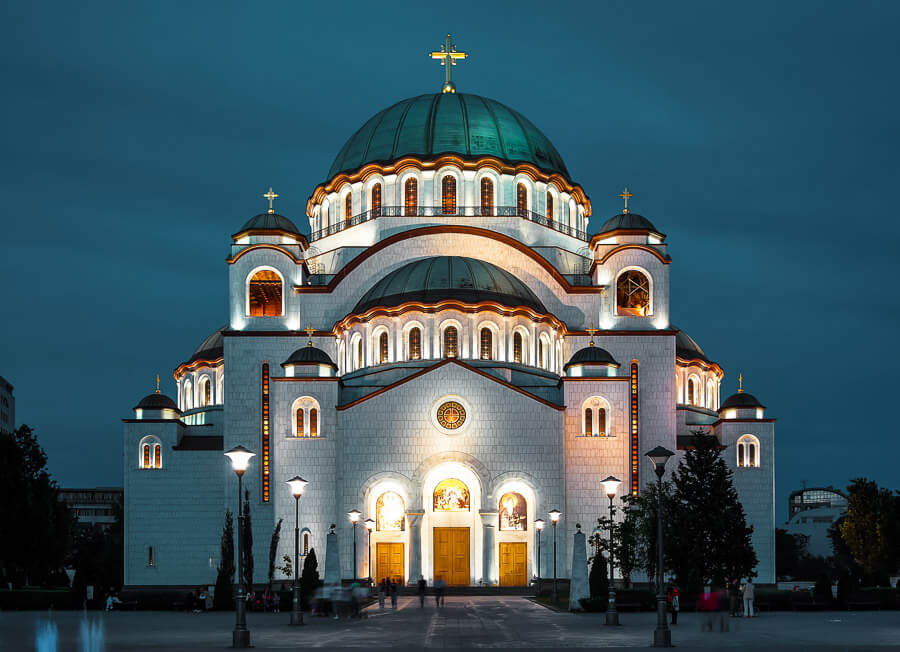
Things to do in Belgrade
- Visit Kalemegdan Fortress. Belgrade Fortress sits at the confluence of the Danube and Sava Rivers and affords magnificent views of New Belgrade. Entrance is free.
- Get hands-on at the Nikola Tesla Museum. Serbia holds claim to inventor and engineer Nikola Tesla as their favourite homegrown hero. His museum in Belgrade is fascinating – even (or especially) if you don’t know much about his work. The Tesla Coil Demonstration will make your hair stand up on end. Entrance to the museum costs 500 denars (approx. 5 USD) per person.
- Visit the House of Flowers. This is the final resting place of another historical icon associated with Serbia, albeit for very different reasons. Josip Broz Tito’s mausoleum is an extravagant greenhouse-like atrium surrounded by lovely gardens. The adjacent Museum of the History of Yugoslavia is a huge, fascinating display of Yugoslav history. The whole thing is slightly macabre, but it’s a must-see in Belgrade
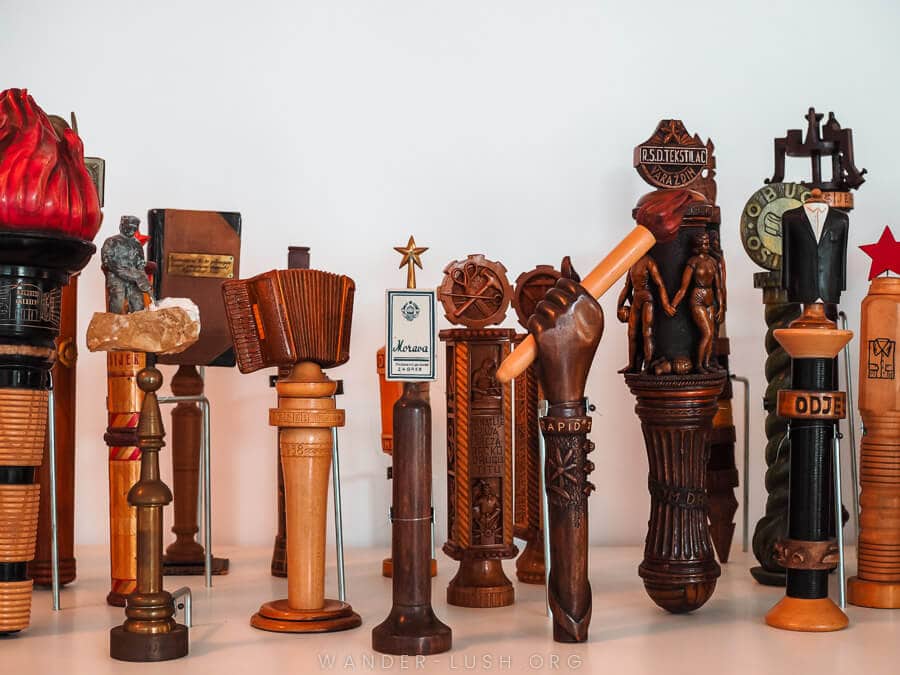
- Wander back in time in Zemun. Located behind New Belgrade, Zemun was described to me by a local as ‘a city within a city’, and it certainly feels that way. This was a separate town until it was absorbed into Belgrade in the 1930s, and locals have managed to hold onto that romantic small-town feel. You’ll find a picturesque town square, lively outdoor markets, and more cafes than you can count.
- Summit Avala Tower for a view. This icon of Belgrade’s skyline was famously destroyed during the war and later rebuilt. Today it contains an observation deck and cafe at the top. Access to the tower is via a lovely hiking trail that starts on the outskirts of the city. Entrance costs 300 denars (approx. 3 USD) per person.
Read more: My complete guide to visiting Avala Tower from Belgrade.
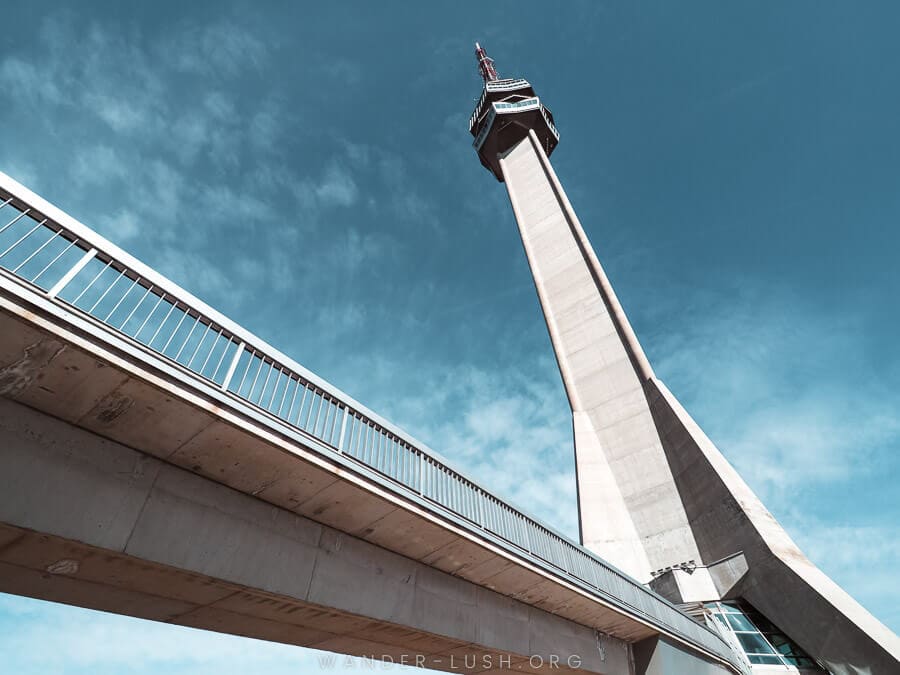
- Bike around New Belgrade: The best way to explore New Belgrade, the western half of the city, is by bike. This area is pancake-flat and there are a number of pathways that link monumental concrete buildings such as the Hotel Yugoslavia with Belgrade’s vast commieblocks and pockets of green parkland. We joined a guided cycling tour with local company iBike and loved it.
- Try a slice of Moscow Shnit. Belgrade’s favourite sweet treat is a delicious cake prepared at Hotel Moscow in the city centre. The recipe is a guarded secret, but I can tell you it’s very light and fruity (perfect for enjoying on the outdoor terrace under a blue sky). The hotel and cafe are iconic in Belgrade.
Where to stay in Belgrade
We stayed at the exceptional Downtown Art Deco Studio, located right in the centre of the city. It was one of the best apartments we stayed at anywhere in the Balkans.
Most Belgrade Airbnbs are concentrated around the northern end of the city on the eastern side of the river. This is also where you’ll find most museums and tourist attractions, plus some great restaurants.
I recommend staying in either the Skadarlija or Dorcol (the oldest part of Belgrade) neighbourhoods.
If you prefer a hotel, these properties are all centrally located and have excellent ratings (9/10 or higher) on Booking.com:
- Budget hostel: Balkan Soul Hostel
- Mid-range hotel: Hotel Rex
- Boutique hotel: Mama Shelter Belgrade or 7 Rooms Suites
Days 6 & 7: Finish on a high in Tara National Park
It’s a bit of a mission to reach central Serbia’s western corner, but it’s more than worth the long bus ride. Tara National Park is the most heavily forested part of the country and is widely considered to be Serbia’s most pristine pocket of nature. Yet relatively few foreign tourists ever make it here.
Aside from hiking and river sports on the Drina, this area is also brimming with cute villages, history and culture, so there’s something for everyone at any time of year.
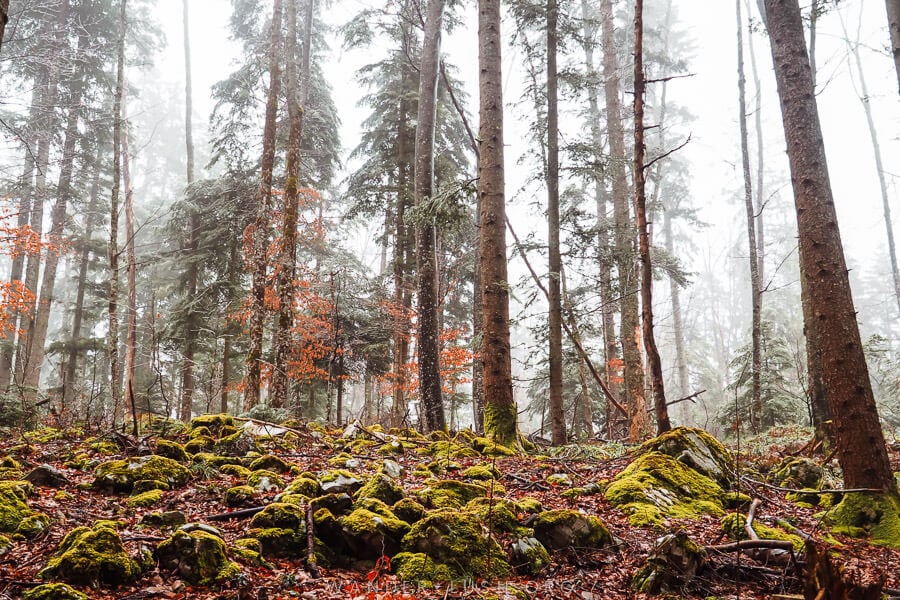
How to get to Tara National Park from Belgrade
There are no direct buses from Belgrade to the towns of Mokra Gora or Mitrovac, so you need to transfer through the town of Zlatibor to access the park.
There are a dozen direct buses to Zlatibor leaving Belgrade’s main station from 6.15am onwards. Travel time is around 4 hours, and tickets cost around 13 Euros (or 18 Euros return) when reserved online. Check times and prices here.
Travel time from Zlatibor to Mokra Gora is 30 minutes and can be done either by local bus or taxi.
If you want to avoid a long morning of travel and you have to get back to Belgrade for your flight home anyway, another option is to take a day trip to Tara National Park from Belgrade. This full-day tour includes transfers from Belgrade with a professional driver and a guide to show you all the highlights of the beautiful Drina River Valley.
We did something similar and visited Tara National Park on a day trip from Sarajevo.
Things to do in and around Tara National Park
- Go hiking. There are marked trails all over the park, ranging from short day hikes to multi-day affairs. Most start from Mitrovac where there is a tourist office that can furnish you with maps.
- Photograph the cute Drina River House. A wooden house perched on a stone in the river that marks the border between Serbia and Bosnia and Herzegovina, this is one of the icons of Tara National Park.
- Admire the frescoes at Raca Monastery. A 13th-century monastery containing a set of important paintings. There are several hiking trails to fresh water springs in the area.
- Visit the weird and wonderful Drvengrad village. Originally built as a film set for the movie Life is a Miracle, this charming model village has become a symbol of Serbia. The film director’s personal collection of vintage cars are scattered amongst the wooden houses and churches. There is a film festival held here every summer.

- Ride the historic Sargan Eight Steam Train. Construction on this narrow-gauge railway started during World War I to link Serbia and Austro-Hungary. Today it’s a scenic railway that runs between the towns of Mokra Gora and Vitasi via tracks that cling to the side of the mountain valley.
- Catch the view from Banjska Stena. It was a sea of fog when we visited Tara National Park’s most famous viewpoint, but I’ve been reassured that the panorama is phenomenal on a clear day!
- Venture to Zlatibor. Serbia’s most popular mountain resort town is located south-east of the National Park, in the shadow of Mount Zlatibor. Here you can find lovely accommodations and more hiking trails.
Where to stay near Tara National Park
The most popular places to stay when visiting Tara National Park are Mitrovac (a good base for hiking) and Mokra Gora. There are some lovely homestyle accommodations in and around the national park – my favourite is this sweet cabin.
See more options in Mokra Gora on Booking.com.
Extend your Serbia itinerary: Other places to visit
If you have more time, you might consider including one or more of these additional destinations to your Serbia itinerary.
Uvac Nature Reserve – add 1-2 days
Located south of Mokra Gora and Tara National Park, this park features biodiverse wetlands and a very picturesque winding river.
To get there, you can take a train to Nova Varos and spend a few nights inside the park, or you can join a day tour from Belgrade.
Nis – add 1-2 days
Serbia’s third-largest city, Nis is located in the country’s south-east, around 230km from Belgrade. It’s accessible by coach from the capital or if you want to add it to the end of your itinerary, you can take a bus from the city of Uzice near Tara National Park.
I didn’t get to visit Nis this time, but I’d love to go back and spend some time exploring the city that traditionally linked Belgrade and Istanbul. (I had no idea Nis was the birthplace of Roman Emperor Constantine the Great.)
If you’re planning a visit, I recommend this guide to Nis.
Novi Pazar – add 2-3 days
Also located in southern Serbia, Novi Pazar has always been considered Serbia’s cultural and religious crossroads. It has a long and fascinating history, as evidenced by the many important monuments located in and around the city.
You can learn more about Novi Pazar here.
Onward travel from Serbia
If your flight home is departing from the capital, you can simply loop back to Belgrade from Tara National Park (departing Uzice or Zlatibor) by bus.
If you’re continuing on overland, you can transit west into Bosnia and Herzegovina (first stop: Visegrad) or north-west into Croatia. Another option is to head to Novi Pazar from Tara National Park then continue overland to Montenegro.
Can you cross into Kosovo from Serbia?
If you want to continue your travels in Prishtina and Prizren, you’ll need to read up on the different options for getting to Kosovo to Serbia. There are rules in place that could prevent you from visiting Serbia again in the future, so it’s very important you do your due diligence.
Refer to this detailed guide about crossing into Kosovo legally.

One of the best blogs I have come across online. Everything a traveler should know about a country/place is very well captured and explained. Thanks a lot. More power to you!
Thanks Nabeel for the kind words!
Absolutely very useful blog, am sure this help me plan well for my serbia trip.
Thanks for your comment, Dheepan! Happy travels to Serbia!